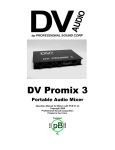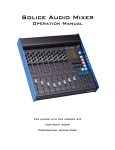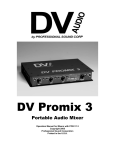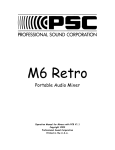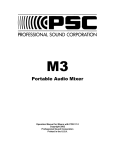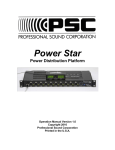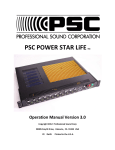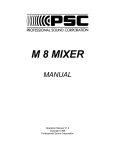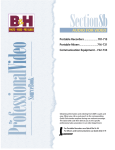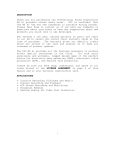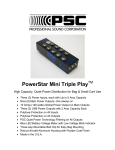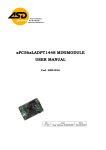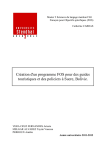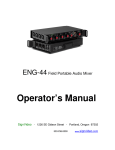Download Professional Sound Corporation DV Promix 3 Specifications
Transcript
ProMix 6 Audio Mixer Operational Manual For PCB Version 1.7 Copyright 2007 Table of Contents Page Overview 2 Applications 3 Hearing Safety Warnings 3 Construction 4 Block Diagram 5 Input Panel View 6 Pre-Amplifiers 6 Gain Settings 6 Microphone Powering 7 Dedicated Line Outputs 7 Headphone Outputs 7 Front Panel View 8 Channel Fader 8 High Pass Filters 8 Channel Assignment Switch 8 Pre-Fade Listen Switch 8 Peak Reading Meters 9 Power Switch 9 Slate Microphone 10 Reference Oscillator 10 Limiters 10 Headphone Selection 10 1 Table of Contents Continued Page Headphone Volume 11 Right Side Panel View 11 Main XLR Outputs 11 Auxiliary Outputs 12 Ganging Connection 12 External Power Connection 12 Tape Returns 13 Battery Door 13 Interfacing 14 RoHS 15 Warranty 16 Specifications 17 CE Mark 18 Overview: Thank you for purchasing the Professional Sound Corporation ProMix 6 portable audio mixer. We are confident that you will find this mixer has set new standards in mixer technologies and features at an affordable price. If you have any questions, comments, or suggestions about this mixer or any other PSC product, please do not hesitate to call or e-mail us. Additionally, we invite you to share your suggestions for new products you would like to see developed. Professional Sound Corporation extends a one-year warranty on parts and labor to all ProMix 6 owners who return their warranty cards at the time of purchase. This warranty gives you specific legal rights, which are stated on the warranty card, and enables us to keep you informed of product updates. The PSC ProMix 6 provides all of the functions necessary to produce studio quality recordings in the field. It’s user friendly features, rugged design and sonic 2 purity make the ProMix 6 perfect for electronic news gathering (ENG), electronics field production (EFP), reality television production and feature film production. APPLICATIONS: • Electronic News Gathering • Location recording (Dialog and Music) • Digital Recoding and Playback • Broadcast Remotes • Desktop Mixing for Video Post Production • Reality Television Production HEARING SAFETY WARNINGS: Please be sure that you have read this entire manual before operating this mixer. While special attention has been given to your safety and hearing protection, the operator determines proper and safe operating levels. Please note the following: Always turn down the headphone volume before plugging in your headphones. Always operate your headphones at the lowest practical level. Be especially cautious in unknown or widely varying environments. Remember, your ears are your livelihood! Turn it down! 3 Construction Chassis: The ProMix 6 chassis has been designed for maximum tensional rigidity. This increased rigidity provides a stable base for the mixer’s modern electronics. The complete chassis is formed from 0.040” and 0.050” aircraft aluminum. All punching is done on a computer controlled Trump rotary turret punch press for extreme accuracy. In addition, through careful design, we have managed to keep the overall weight of the PSC ProMix 6 down to less than 4 lbs (1.8Kg) The mixer’s sheet metal is then hand formed using a computer controlled six axis Cincinnati press brake. Threaded inserts are then pressed permanently into place and mixer cases are then painted. Electronic Topology: The new PSC ProMix 6 audio mixer was designed from a clean sheet of paper. It utilizes new circuitry designed using the latest advances in semi-conductor technology for improved performance and to further reduce the size and weight of the product. The ProMix 6 uses proprietary pre-amplifier designs that are the result of many hours spent testing and tweaking the input circuitry. We believe that you will find these pre-amplifiers to be very quiet. In addition, the ProMix 6 also uses our exclusive, super high quality output transformers. These transformers are made to our specifications and custom built for our use. They are hands down the largest, dual isolated output transformers used in any ENG style mixer. We use them in our flagship AlphaMix as well. Future Environmental Outlook: The PSC ProMix 6 is fully RoHS compliant. It is built using lead free parts and lead free solder. This is the first ENG style mixer to be built specifically to meet the tough demands of the European Union’s RoHS standards. PSC is committed to keeping our environment safe and clean for future generations. Environmental Operation: Your new PSC ProMix 6 audio mixer has been designed to operate under extreme field conditions. The electronics have been designed to operate over a temperature range of -4 to +158 degrees Fahrenheit (-20 to +70C) less the effects on the batteries. This is in addition to the ProMix 6’s ability to operate in high humidity conditions and makes it perfect for harsh field conditions. 4 5 Input Panel View Pre-Amplifiers The inputs of the PSC ProMix 6 are all female XLR connectors and the input circuitry is balanced. Careful attention was given to RF immunity for the input circuitry to help eliminate RF problems in the field. The XLR connectors are wired as follows: Pin 1 = Ground, Pin 2 = High (Audio in Phase), Pin 3 Low (Audio out of Phase) Gain Settings The six input channels of the PSC ProMix 6 use pre-amplifiers that are designed for real-world ease of use. These pre-amplifiers have 3 basic gain settings. These gain settings are labeled: C (Condenser Microphone) L (Line Level Input) and D (Dynamic Microphone) Using these 3 settings makes for easy and fast setups in the field. You must simply select the gain setting that best matches your input signal and you are done. Typically, Condenser microphones (powered microphones) have a higher output level than that of a dynamic microphone. To use a condenser microphone, just set the input gain setting switch to “C”. To use a dynamic microphone, set the input gain switch to “D” When using line level sources, set the input gain setting switch to “L” When using most wireless microphone receivers, set the input gain setting switch to “C”. Microphone Powering The PSC ProMix 6 audio mixer is equipped with 48PH microphone power. Each of the six input channels has a separate switch to enable the 48PH microphone power for that individual channel. These switches are labeled “D” and “48”. In the “D” position, there is no microphone power being applied to that XLR input. 6 In the “48” position, 48 Phantom microphone power is being applied to that input XLR connector. Please note that you should only use the “48” setting when powering microphones that are designed to operate from 48PH power. If you want to power up older Sennheiser “T” power microphones, you will need to use a PSC 48PH to 12T adapter barrel (part # FPSC0010A, available from any PSC dealer). Please also note that 48PH is not needed or compatible with most wireless receivers. If using wireless, turn that input’s microphone powering switch to “D”. Dedicated Line Outputs Each of the six inputs found on the PSC ProMix 6 audio mixer are equipped with individual line outputs. These line outputs feed pre-fader audio from the corresponding input. They feature a ¼” line output jack operating at a nominal level of -10dBv. These six outputs are un-balanced and are wired as follows: Tip = audio signal, Ring = unused, Sleeve = Ground. These outputs can be used for IFB feeds, individual camera feeds and for wireless transmission hops. Headphone Outputs The PSC ProMix 6 is equipped with two headphone jacks. These two jacks are wired in parallel. One is a standard ¼” stereo jack and the second connector is a 3.5mm Mini stereo jack. Either jack may be used to drive headphones with any impedance from 25 ohms to 600 ohms. Front Panel View Channel Fader The PSC ProMix 6 audio mixer has six fader pots located across the front panel. Each one of these fader pots controls the audio level of its corresponding input. Rotating the fader pot clockwise increases audio level. Rotating the fader pot counter-clockwise decreases the audio level. 7 High Pass Filters The ProMix 6 is equipped with 3 way switch-able high pass filters on each of the six input channels. These filters can be activated by switching the appropriate front panel mounted switches. The switches are labeled as follows: 80, 20, 140. These numbers represent the cut off frequencies of the high pass filters. In the “20” position, the frequency response is flat down to 20Hz. In the “80” position, the low frequencies are rolled off with a -3dB point of 80Hz. In the “140” position, low frequencies are rolled of with a -3dB point of 140Hz. The “80hz” setting is used for basic low frequency roll offs such as operating indoors with airconditioning on or outdoors in light wind conditions. The 140Hz position provides more severe low frequency roll off and is used in high wind conditions. Channel Assignment Switch Each of the six input channels has a Channel Assignment switch that is located on the front panel above the channel fader pot. These switches are used to route the audio signal from each individual input to the appropriate output bus. The switches are labeled as follows: L, C, and R. When set to “L”, the signal is routed to just the left output bus. When set to “C” (Center) the signal is routed to both the left and right output busses. When set to “R” the signal is routed to just the right output bus. Pre-Fade Listen Switch Each input channel of the PSC ProMix 6 is equipped with a Pre-fade Listen switch. These push button switches are used whenever you wish to individually monitor that input’s audio via your headphones without having to open the fader. By pressing the momentary button down, your headphones will automatically be switched to monitor just that input channel. As soon as you release the PFL button, your headphones go back to monitoring your standard headphone selection. These PFL switches are labeled “PFL” and are located below the channel faders. They are very useful for setting up wireless, checking for wireless dropouts, and previewing performer audio levels without having to open up a channel fader. In this manner, you can check on a given input without disturbing your ongoing recording. Peak Reading Meters The ProMix 6 is equipped with peak reading LED meters. These meters use high brightness LEDs for easy reading even in bright outdoor conditions. In addition, there is a screw driver trim pot control located just below the meters that allows for adjustment of meter brightness. These meters read and respond to the peak level of the audio signal. They are useful when recording to today’s digital formats. The LEDs are multi colored to allow quick visual checking of the meter levels. The LEDs that represent audio levels of -21dB to -3dB are GREEN 8 in color. The LEDs that represent “0dB” are YELLOW in color and the LEDs that represent +3dB or greater are RED in color. Thus you can just give a quick glance to the meters and determine if your audio levels are too high by noting the color present. Power Switch On the lower right hand corner of the front panel is the main power switch. This switch controls all of the power used to operate the ProMix 6 audio mixer. This switch is labeled “PWR” and is a three position switch. In the left most setting, the switch is labeled “EXT” and this refers to external power. The mixer will operate when the switch is set to EXT and it is connected to an external power source such as an AC wall supply or external battery. In the center position, the mixer is turned off. In the right most position marked “BATT” the mixer will operate from its internal batteries. Whenever the mixer is turned on, the first LED in each row of meter LEDs will light up Blue. This indicates proper operating voltage is present in the internal batteries or the external power source. When the batteries get low, these two blue LEDs will begin blinking. This blinking condition indicates that the batteries useful life is nearly over and you should stop and change your batteries soon. Actual remaining battery life is dependent upon use of the mixer, number of powered condenser microphones being used etc. You can typically expect 15 to 20 minutes of remaining run time once the blue LEDs begin blinking. Slate Microphone The PSC ProMix 6 audio mixer is equipped with an internal slate microphone. This slate microphone is used to provide on tape, voice slating of scène and take notes, editing notes and other voice notes for future use. To operate the slate microphone, simply press the “Slate Mic” button. This button is momentary and thus the slate microphone will only activate for as long as you press the button. There is also a slate microphone volume level trim pot located just to the left of the slate mic button. Reference Oscillator The ProMix 6 audio mixer is equipped with a reference tone oscillator that is used to provide a reference tone level for production editing. This tone oscillator puts out a 440Hz tone at 0dB on the meters. At the beginning of each tape or at the first use of any other audio storage format, you should record a 15 to 20 second burst of reference tone. This tone will be used later in post production to set proper audio levels for subsequent transfers and is used to keep audio levels consistent among multiple cameras. 9 Limiters The ProMix 6 audio mixer is equipped with switchable output limiters. The control switch for these limiters is located on the right hand side of the front panel between the tape return monitor switch and the power switch. The output limiter switch is labeled “LIM” and is a three-way switch. The three choices are labeled “Off” , “S” , and “G” In the “off” position the limiters are turned off and no output signal limiting occurs. In the “S” (separate) position, the two limiters act independently of each other. This position is used most often when you have an interviewer panned to one output and the interviewee panned to the other output. This type of recoding is called split tracks and you should use the limiters in their “S” mode for this type of work. In the “G” (ganged) position, the limiters are ganged together and will track one another. If a high level signal on either limiter input causes one of the limiters to activate, both limiters will activate. This type of limiting is normally used when recording stereo signals. By keeping the limiters ganged together, the overall stereo image will not appear to shift when limiting occurs. It is highly recommended that you use the output limiters at all times. This will serve to protect your recording from unexpected audio peaks that would otherwise overload your recorder and ruin the sound quality of your recordings. In most ENG situations, split tracks are used and thus the “S” setting on the limiter switch is employed. Headphone Selection On the right side of the front panel there is a rotary switch that is used to control what you monitor on your headphone outputs. This switch has four positions that are marked as follows: “S”, “L”, “R”, and “M” These settings are abbreviations for Stereo, Left, Right, and Mono. In the “Stereo” setting, the headphones are fed a normal stereo signal. The left headphone is fed a signal from the left output and the right headphone is fed a signal from the right output. When the switch is set to “Left”, both drivers of your headphones are fed a signal from the left output. When this switch is set to “Right” both drivers of your headphones are fed a signal from the right output. When set to “Mono” both headphone drivers are fed a signal that is a mono sum of both the left and right outputs. Headphone Volume Located directly above the headphone selection switch is a headphone volume control pot. This pot raises or lowers the volume of the audio signal going to your headphones. Turning the pot counterclockwise will lower the volume. Turning the pot clockwise will raise the volume of the headphones. Turning the pot fully counterclockwise will turn off the headphone volume completely. Please note the headphone volume safety warnings at the beginning of this manual. Operating this mixer with too high of a headphone volume setting may cause permanent hearing damage. You are fully responsible for your own hearing protection when using this mixer as we do not have control over your operating 10 environment, headphone type and use, operating levels, microphone type, etc. Remember, your ears are your livelihood, Turn it Down! Please also note to turn down the headphone volume each time before you plug in your headphones. Right Side Panel View Main XLR Outputs The ProMix 6 contains two independent sets of XLR outputs. These are located on the right hand side panel of the mixer. They are labeled as “Camera A” Left and Right and “Camera B” Left and Right. These XLR outputs provide balanced audio feeds at various audio levels. Below each XLR connector is a three way toggle switch to control the output level. These switch settings have labels of “0”, “-10”, and “-50”. When any of these switches is set to “0”, the nominal audio output level is 0dBV. When set to “-10”, the nominal audio output level is -10dBv and when set to “-50” the nominal audio output level is -50dBv. These audio signal levels correspond to the following: 0dBv corresponds to professional line level, -10dBv corresponds to consumer line level and -50dBv corresponds to microphone level. The two sets of XLR outputs are isolated from each other using our proprietary dual isolated output transformers. Auxiliary Outputs On the right hand side panel of the ProMix 6 audio mixer are two jacks labeled as “Aux 1” and “Aux 2”. These are the two auxiliary audio outputs. They are both ¼” stereo signal jacks. Pin outs are as follows: Tip = Left signal, Ring = Right signal, Sleeve = Ground. Both of these auxiliary audio outputs have two-way level selection switches located directly below each output jack. These switches allow the signal to be sent out at either -10dBV (consumer line level) or -50dBv (microphone level). These auxiliary outputs can be used to drive IFB transmitters, transcription recorders and other devices. They can also be used to feed the ganging input connector of another ProMix 6. 11 Ganging Connection The PSC ProMix 6 also is equipped with a “Gang Input” connector. This connector allows the user to have access to the left and right mix busses within the mixer. This connector can be used for connecting other mixers and audio sources into the ProMix 6. Typically, another mixer’s output would be connected into the ProMix 6’s ganging input to allow a greater number of input channels to be routed through the ProMix 6. To gang two ProMix 6’s together, you must simply connect a cable that has a ¼” stereo connector on each end from one of the ProMix 6’s (slave unit) auxiliary outputs to the other ProMix 6’s (master unit) ganging input. The master unit will now allow you to meter, monitor and output all 12 of the inputs of the two mixers. External Power Connection On the upper right corner of the right hand side panel of the ProMix 6 audio mixer you will find a 4 pin Hirose connector labeled as “EXT PWR” This connector is used to connect an external source of power to operate the ProMix 6. This connector uses industry standard pin-outs of Pin 1 = Ground and Pin 4 = Positive power. Any external source of DC power may be used as long as it is within the range of 7 to 18Vdc. All external sources should be externally fused for protection. Any external power supply should also be rated to provide a minimum of 300mA for proper operation. Internally the mixer is protected against reversed polarity. If you incorrectly provide the external power connector with the wrong polarity, the mixer will not be damaged, it simply will not power up. Tape Returns Your new PSC ProMix 6 is designed to be operated with up to two cameras. Because of this, the ProMix 6 has two sets of tape return monitor inputs. These are normally used with the corresponding two camera outputs. The two tape returns are located on the right hand side panel along the top edge directly above the XLR outputs. These two jacks are 3.5mm stereo mini jacks. Normally you would connect the tape return plug(s) from one or two of our PSC Beta snake cables to these jacks. The use of these jacks allows the operator to monitor the tape return signal from his cameras, thus insuring a proper connection to the camera and/or that proper recording has taken place depending on the camera model. Adjacent to the jacks there are screw driver trim pots for easy level adjustment and matching. These are used to set proper audio levels so that when you switch from monitoring audio from the mixer to monitoring audio form the tape returns, you have the same consistent levels throughout. Battery Door / Battery Compartment The battery compartment is located on the right hand side panel of the mixer. The PSC ProMix 6 uses 8 AA alkaline or Lithium batteries. They are inserted 12 with the bottom row of batteries arranged so that the positive end is pointing into the mixer and the top row so that the positive end of the batteries are pointing out of the mixer (please see photo below). The battery door is removed by turning the battery door thumbscrew counter-clockwise until the door comes free from the mixer. The door is a universal fit, that is to say there is not a top or bottom to the door. Please do not mix new and used batteries or alkaline and lithium batteries as battery leakage may result. Please also do not store batteries in your PSC ProMix 6 audio mixer for extended periods of time. Also do not leave the mixer powered up when in storage. All of these actions may result in battery leakage. Corrosion from leaking batteries may damage your mixer and this type of damage is not covered under the PSC warranty. INTERFACING: To professional and some semi-professional cameras (XLR Inputs) To interface your new ProMix 6 to one or two professional video cameras is easily done. The most simple and convenient way is to use a PSC betasnake cable. These umbilical cables provide a balanced left and right channel audio feed to the camera and also a left and right channel audio monitor return line for use in tape confidence monitoring. All of these functions are contained in a single, very flexible cable. We sell these cables in 25’ long standard versions and 15’ and 25’ breakaway versions. The breakaway versions have a quick disconnect plug near the camera end fan out portion of the cable to allow the user to leave all of the various camera fan out connections in place and simply just unplug one, quick disconnect plug. Though not as convenient, you can use a pair of standard XLR cables to send audio from the ProMix 6 audio mixer to the camera and a separate 3.5mm mini to 3.5mm mini cable to provide the tape monitoring function. Please see the output level setting chart below for further audio level recommendations: 13 To consumer cameras (3.5mm input jack) To interface your ProMix 6 audio mixer to most consumer cameras is easy. You must simply have the appropriate cable to interface the two devices and then set the output level of the ProMix 6 to the correct level to correspond with your camera’s input. In most cases the camera will only be able to work with microphone level. (-50dB) You may use one of the two available auxiliary outputs to feed most consumer cameras. These auxiliary outputs are stereo ¼” jacks on the right hand side of the ProMix 6. You must simply set the audio level for the auxiliary output you are going to use to –50dB and then plug in a cable with a ¼” stereo connector into this jack. The other end of the cable should have a 3.5mm stereo mini plug to be able to plug it into your camera. DEVICE: PRO AUDIO RECORDERS WITH XLR LINE LEVEL INPUTS PRO AUDIO RECORDERS WITH XLR MIC LEVEL INPUTS PRO CAMERAS WITH XLR LINE LEVEL INPUTS PRO CAMERAS WITH XLR MIC LEVEL INPUTS SEMI PRO CAMERAS WITH XLR INPUTS (PD – 150, ETC) SEMI PRO CAMERAS WITH XLR INPUTS (PD – 150, ETC) DEVICE PROMIX 6 PROMIX 6 INPUT OUTPUT OUTPUT CONECTOR CONECTOR SWITCH SETTING XLR, LINE XLR “0” LEVEL SIGNAL LEVEL NOTES: 0dBv Straight XLR Cable XLR, MIC LEVEL XLR “-50” -50dBv Straight XLR Cable XLR, LINE LEVEL XLR “0” 0dBv Straight XLR Cable XLR, MIC LEVEL XLR “-50” -50dBv Straight XLR Cable XLR, LINE LEVEL XLR “-10” Straight XLR Cable XLR, MIC LEVEL XLR “-10dB” -10dBv Consumer Line level PD-150 -10dBv 14 Straight XLR Cable RoHS This new ProMix 6 audio mixer was designed and built to meet the rigorous standards set by the RoHS initiative of the European Union. The RoHS (Reduction of Hazardous Substances) initiative specifies that no electronic product may contain Lead, Mercury, Cadmium and a few other less used, but still dangerous substances. These substances are being eliminated in order to reduce the effects of post consumer waste on disposal sites. In other words, by eliminating lead and other substances in the production of electronic products, you will also eliminate them from being put into waste burial sites once they have outlived their usefulness. By eliminating lead and other substances in waste burial sites, you eliminate possible ground water contamination from these sites. It’s a good long term solution to fight ground water pollution and we at PSC fully support this plan. Several other counties are considering adopting similar standards at the time this manual was written as is the State of California. All Professional Sound Corporation products will meet the RoHS guidelines by the compliance date of July 1st, 2006. Every product PSC makes that meets these guidelines will have the following PSC symbol attached to the outer packaging: WARRANTY AND NON-WARRANTY SERVICE In the unlikely event your ProMix 6 requires service, it should be carefully packed and shipped prepaid to: Professional Sound Corporation Attn: Service Department 28085 Smyth Drive Valencia, CA 91355 USA PH 661-295-9395 FAX 661-295-8398 e-mail: [email protected] Please call before shipping your mixer to us. We may be able to solve your problem via the telephone. During our 20 years in business, many mixers have been shipped into PSC for service with only incorrect switch settings etc. Complete details of the PSC ProMix 6 mixer warranty are given on the enclosed warranty registration card. 15 Specifications: Size: 10.650” x 8.000: x 2.300” (27cm x 20cm x 5.8cm) Weight: 4 Lbs (1.8Kg) Operating Temp: -20F to +140F Less Battery Limitations External Power: 6 to 18Vdc Battery Power: 8 x AA Alkaline Cells Meters: LED, Peak Reading, Multi-Colored Slate Microphone: Electrete Condenser Reference Osc: 440Hz Frequency Resp: 20Hz to 20Khz +/- 0.5 dB Distortion: 0.08% THD Signal to Noise: 128db EIN Cross Talk: 65dB @1Khz XLR Output Levels: 0dBv, -10dBv, -50dBv XLR Output Impedance: <25 Ohms, 600 Ohm rated Tape Return Impedance: 1K Ohm Auxiliary Output Level: -10dBv, -50dBv Ganging Levels: -10dBv 16 CE DECLARATION OF CONFORMITY EMC: This product is in compliance with the Electromagnetic Compatibility Directive, 89/336/EEC as defined in EN 50081-1, EN55022 and EN 50082-1, IEC801-2, IEC 801-3 and IEC801-4. LVD: This product is in compliance with requirements of the Low Voltage Directive, 73/23/EEC, 93/68/EEC as defined in EN60065, 1993and/or EN60950/A1/A2/A3, 1995 TRADE NAME: PSC MODEL: PROMIX 6 REPONSIBLE PARTY: Professional Sound Corp 28085 Smyth Drive Valencia, CA 91355 USA CONTACT PERSON: Ronald Meyer (661) 295-9395 TYPE OF PRODUCT: Audio Mixer MANUFACTURER: Professional Sound Corp 28085 Smyth Drive Valencia, CA 91355 USA We hereby declare that the equipment bearing the trade name and model number listed above has been tested in accordance with the requirements contained in the above listed directives. All necessary steps have been taken and are in force to assure that production units manufactured will conform to Directive guidelines. January 2006 Professional Sound Corporation 17




















